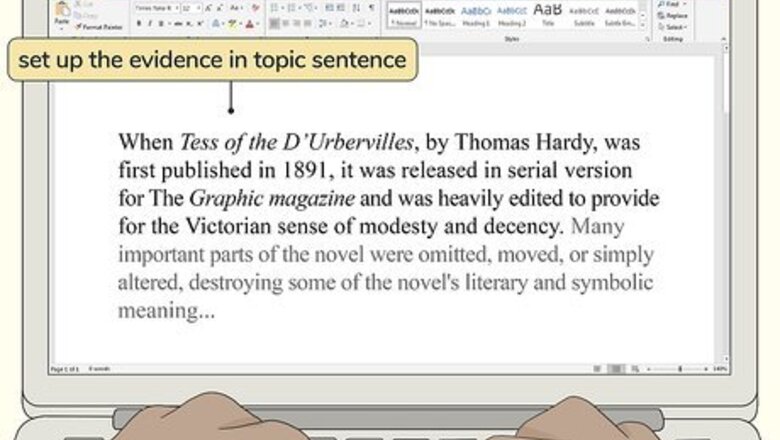
views
Setting up the Evidence
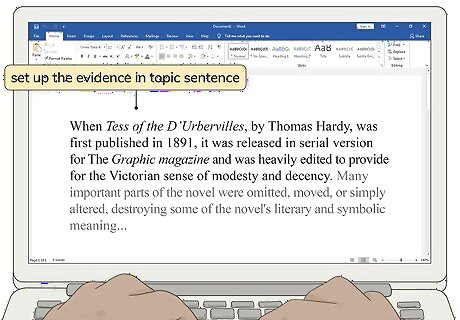
Set up the evidence in the first sentence of the paragraph. The first sentence in the paragraph or section of your essay is called the topic sentence. It should let the reader know what is going to be discussed in the paragraph or section. If the paragraph is one of many in the body of your essay, the topic sentence should also link to the preceding section so the transition to a new section is smooth. You can use 1-2 sentences to set up the evidence, if needed, but usually more concise you are, the better.
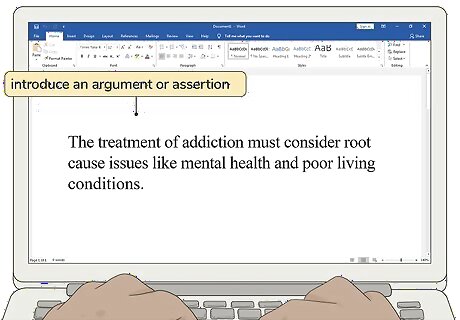
Introduce an argument or assertion. Tell the reader what you think about your main topic or idea. Make an argument or assertion about the topic of your essay. The argument should connect to the evidence you are going to present. For example, you may make an argument like, “Desire is a complicated, confusing emotion that causes pain to others.” Or you may make an assertion like, “The treatment of addiction must consider root cause issues like mental health and poor living conditions.”

Discuss a specific idea or theme for a less direct approach. Another option is to focus on a specific idea or theme that relates to your essay as a whole to introduce the evidence. The idea or theme should reflect a key idea in the evidence you are using. This approach may be a good option if you are writing a paper that is explorative, rather than argumentative. For example, you may write, “The novel explores the theme of adolescent love and desire.” Or you may write, “Many studies show that addiction is a mental health issue.”
Putting in the Evidence

Start with an introductory clause for a simple approach. Use an introductory or lead-in clause so the evidence fits seamlessly in the text. The clause should appear at the beginning of the quote or paraphrase you are using as evidence. For example, you may use an introductory clause like, “According to Anne Carson…”, "In the following chart...," “The author states…," "The survey shows...." or “The study argues…” Place a comma after the introductory clause if you are using a quote. For example, “According to Anne Carson, ‘Desire is no light thing" or "The study notes, 'levels of addiction rise as levels of poverty and homelessness also rise.'" A list of introductory clauses can be found here: https://student.unsw.edu.au/introducing-quotations-and-paraphrases.

Use a claim or argument to introduce the evidence. Another option is to use your own claim or argument to introduce the evidence in a clear, assertive way. Keep the claim or argument short and relevant. Back it up with your sources. Use a colon after the claim or argument. For example, you may write, “In the novel, Carson is never shy about how her characters express desire for each other: ‘When they made love/ Geryon liked to touch in slow succession each of the bones of Herakles' back…’” Or you may write, "The study charts the rise in addiction levels, concluding: 'There is a higher level of addiction in specific areas of the United States.'"
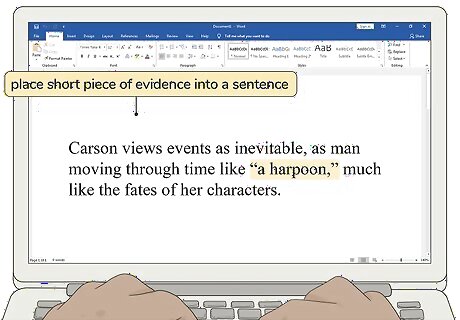
Work the evidence into a sentence. You can also try placing the evidence within a sentence so it flows smoothly and naturally. Use a short piece of evidence in the sentence so it does not come across too long-winded or confusing. For example, you may write, “Carson views events as inevitable, as man moving through time like “a harpoon,” much like the fates of her characters.” Or you may write, "The chart indicates the rising levels of addiction in young people, an "epidemic" that shows no sign of slowing down."

Include the author’s name and the title of the reference. If you are introducing the evidence for the first time in the essay, always include the author’s name and the title of the reference or source when you discuss it. After you mention the author and title the first time, you can use just the author’s last name when you present evidence. For example, you may write in the first mention, “In Anne Carson’s The Autobiography of Red, the color red signifies desire, love, and monstrosity.” Or you may write, "In the study Addiction Rates conducted by the Harvard Review...". After the first mention, you can write, “Carson states…” or “The study explores…”. If you are citing the author’s name in-text as part of your citation style, you do not need to note their name in the text. You can just use the quote and then place the citation at the end.

Use quotation marks around a direct quote. Always place quotes around any direct quotes you use from your sources. The quotation marks should appear around a full or partial quote so the reader knows you are using someone else’s words. If you are paraphrasing a source, you may still use quotation marks around any text you are lifting directly from the source. If you do a paper where you interview somebody, make sure you quote their exact words.

Cite the evidence properly. Include an in-text citation if that is what is required for the citation style you are using. The in-text citation should appear in parentheses at the end of evidence and contain the author’s last name and the page number of where the quote can be found in the original source. Make sure you cite all quotes, charts, graphs, and other resources in your essay. For example, you may write, “In the novel, the characters express desire for each other: ‘When they made love/ Geryon liked to touch in slow succession each of the bones of Herakles' back (Carson, 48).” Or you may write, "Based on the data in the graph below, the study shows the 'intersection between opioid addiction and income' (Branson, 10)." If you are using footnotes or endnotes, make sure you use the appropriate citation for each piece of evidence you place in your essay.

Reference your sources when you use a paraphrase or summary as evidence. If you are using a paraphrase of a source or a summary of an original text, make sure you still use the proper references and citations. If you feel you use some of the wording from the original source in the paraphrase or summary, include a citation based on the citation style you are using in the essay. You may also mention the title of the work or source you are paraphrasing or summarizing and the author's name in the paraphrase or summary. For example, you may write a paraphrase like, "As noted in various studies, the correlation between addiction and mental illness is often ignored by medical health professionals (Deder, 10)." Or you may write a summary like, "The Autobiography of Red is an exploration of desire and love between strange beings, what critics have called a hybrid work that combines ancient meter with modern language (Zambreno, 15)."
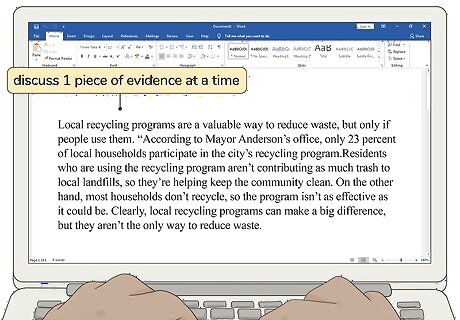
Discuss 1 piece of evidence at a time. Always include a complete analysis of 1 piece of evidence before moving on to the next one. Placing 2 pieces of evidence in succession without analyzing the first one can be seen as sloppy or underdeveloped. The only time you should place 2 pieces of evidence together is when you want to directly compare 2 short quotes (each less than 1 line long). Your analysis should then include a complete compare and contrast of the 2 quotes to show you have thought critically about them both.
Analyzing the Evidence

Discuss how the evidence supports your claim or argument. Take the time to explain the significance of the evidence you introduced in your essay. Tell the reader how the evidence supports the claim or argument you used to set up the quote. Explore how the evidence addresses a theme or idea that you think is important in your discussion. For example, you may write, “In the novel, Carson is never shy about how her characters express desire for each other: ‘When they made love/ Geryon liked to touch in slow succession each of the bones of Herakles' back (Carson, 48). The connection between Geryon and Herakles is intimate and gentle, a love that connects the two characters in a physical and emotional way.” Or you may write, "In the study Addiction Rates conducted by the Harvard Review, the data shows a 50% rise in addiction levels in specific areas across the United States. The study illustrates a clear connection between addiction levels and communities where income falls below the poverty line and there is a housing shortage or crisis."

Address how the evidence relates to your thesis statement. Link the evidence back to the key ideas or themes in the thesis statement of your essay. This will reinforce to the reader that the evidence is relevant and illustrate that you have thought critically about the evidence. For example, you may write, “Carson’s treatment of the relationship between Geryon and Herakles can be linked back to her approach to desire as a whole in the novel, which acts as both a catalyst and an impediment for her characters.” Or you may write, "The survey conducted by Dr. Paula Bronson, accompanied by a detailed academic dissertation, supports the argument that addiction is not a stand alone issue that can be addressed in isolation."

Include a final sentence that links to the next paragraph. Wrap up the section by including a last sentence that presents final thoughts about the evidence and acts as a transition to the next paragraph or section. You can use a short sentence that discusses a final point or idea you had about the evidence. You can also mention a key theme or idea in the next section as a segue. For example, you may write, “The value of love between two people is not romanticized, but it is still considered essential, similar to the feeling of belonging, another key theme in the novel.” Or you may write, "There is clearly a need to reassess the current thinking around addiction and mental illness so the health and sciences community can better study these pressing issues."














Comments
0 comment